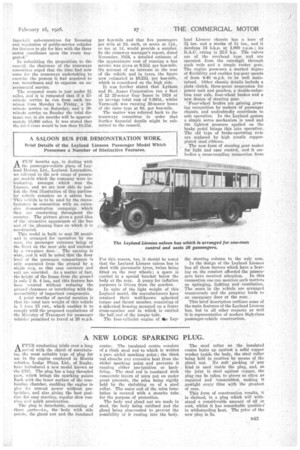A SALOON BUS FOR DEMONSTRATION WORK.
Page 27

If you've noticed an error in this article please click here to report it so we can fix it.
Brief Details of the Leyland Lioness Passenger Model Which
1 Possesses a Number of Distinctive Features.
AFEW Months ago, in dealing with the passenger-vehicle plans of Leylaud Meters, Ltd., Leyland; Lancashire, we referred to the new range' of passenger models which the company were introducing, amongst which was the Lion ese, and we are now able to pub' lish the first illustration of this particular vehicle complete as a saloon bus. This vehicle is to be used by the manu facturers connection with an extensive demonstration campaign which they are conducting throughout the country. The picture gives a good idea of the attractive appearance of the bus and of the pleasing lines on which it is coil structed.
• This model is built to seat 26 people and is arranged for operation by one men, the passenger entrance being at the front on the near side and enclosed by a two-piece door. , The opening is • wide, and it will be noted, that the floor level of the Passengen compartment is only separated from the ground by a • single step, so that easy entrance and exit are provided. As a matter of fact, the height of the frame from the ground is only 2 ft. 4 ins., and this feature has been secured without reducing the ground clearance or interfering with the accessibility of important components.
A point worthy of special mention is that the total tare weight of this vehicle is 3 tons 15 cwt., which enables it to comply with the proposed regulations of the Ministry of Transport for passenger vehicles permitted to travel at 20 m.p.h. For this reason, too, it should be noted that the Leyland Lioness saloon bus is shod with pneumatic tyres, twins being fitted on the rear wheels; a spare is carried in a special bracket below the body• at the rear. A pump for inflation purposes is driven from the gearbox.
In spite of the light weight of this Leyland model, tire manufacturers have retained their well-known spherical torque and thrust member, consisting of a spherical housing Mounted on a frame cross-member and in which is carried the ball end of the torque tube.
The four-cylinder engine of like LeY land Lioness chassis has a bore of 3t ins, and a stroke of 5i ins., and it develops 34 13.11.p. at 1,000 r.p.m.; its R.A.C. rating is 22.5 h.p. The valves are of the overhead type and are operated from the camshaft through push rods and a simple rocker gear. The engine possesses a marked degree of flexibility and enables top-gear speeds of front 4-40 m.p.h. to be well maintained. Other chassis details include a plate clutch, three-point suspension for
• power unit and gearbox a double-reduction rear axle, four-wheel brakes and a new design of steering gear. 'Four-wheel brakes are gaining growing recognition by makers of passenger chassis, and undoubtedly contribute to • safe operation. In the Leyland system a simple servo mechanism is used and the lightest pressure applied on the brake pedal brings this into operation. The old type of brake-operating rods are replaced by high tensile copperplated steel ribbons.
The new form of steering gear makes for light and easy control, and it embodies a cross-coupling connection from the steering column to the axle arm.
In the design of the Leyland Lioness bus all those factors which have a bearing on the comfort afforded the passengers have received attention. In this connection one can mention such matters as Springing, lighting and. ventilation. The meta in the vehicle are arranged transversely and the gang-way leads to an emergency -door at the rear.
This brief description outlines some of the main features of the Leyland Lioness bus, but in all other .respects as well it is representative of modern high-class Passenger-vehicle construction.
































